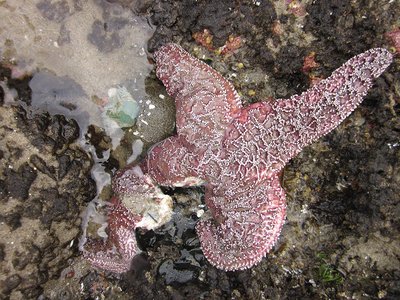
Sea stars are known for their ability to regenerate limbs, but a vicious disease now sweeping the Oregon coastline is causing sea stars to rot and disintegrate much more quickly than their powers of regeneration can handle. If the die-off continues and we lose Oregon’s iconic orange and purple sea stars, local extinctions could cause long-term trouble for other marine animals.
“The way the rate has accelerated, I don’t think most sea stars along the Oregon coast are long for this world,” says Bruce Menge, a marine ecologist with Oregon State University.
“They can pull their arms off, ending in disintegration,” Menge says. “We’ve seen their arms crawl away from them.”
While sea star wasting disease was first observed in Washington in June 2013, it didn’t spread to the Oregon coast until April of this year, and since then, the disease has ravaged Oregon sea stars at an alarming rate. Sea stars are commonly called starfish, a term scientists don’t use because sea stars are not a fish.
Menge says that his research team monitors purple ochre sea stars at a dozen research sites along the Oregon coast, including Cape Perpetua, Cape Foulweather and Seal Rock. In early-to-mid April, less than 1 percent of observed sea stars had the disease. By the end of May, the numbers shot up to 40 to 60 percent at most research sites. The disease can kill a sea star in a week or less, and it is currently affecting 10 species of sea stars.
Scientists don’t have any conclusive explanations for the disease. Researchers at Cornell think a virus might be to blame, Menge says, but they “still don’t have the smoking gun.”
Several ideas exist: If the disease is waterborne, it could travel hundreds or thousands of kilometers in a short amount of time, not restrained by the limitations that airborne diseases face.
Another idea, Menge says, is that the sea stars harbor a kind of virus or bacteria that is normally harmless, but a shift in habitat conditions, perhaps caused by climate change, has triggered the infective agent to become lethal.
Sea stars play important roles in ocean ecosystems, preying on mussels in the rocky intertidal zone, and without sea stars, mussels could gradually take over the lower shore and squeeze other species out.
Menge says sea stars have experienced episodes of wasting before, but it’s usually localized and doesn’t last. In the ’70s, he says he observed a wasting episode in New England, and the sea stars disappeared for a season. “Fortunately for that site, a lot of juveniles survived it,” he says. “We don’t know if that’s going to happen this time.”